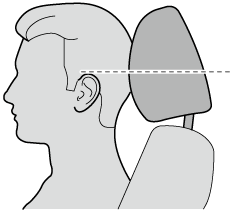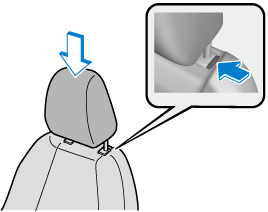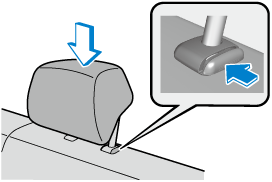Seats
Front Seat
Adjusting the Driver's Seat
Using the driving position set up procedure recommended by Mazda allows you to maintain a relaxed posture, drive the vehicle for longer periods without feeling tired, and make quick operations naturally.
Also, you can be assured of a clear view in the forward direction to help you drive more safely and comfortably.
The adjustments for the driving position recommended by Mazda are done using the following procedures.
-
Moving the steering wheel and seat to their default positions.
-
Adjusting the seatback angle.
-
Adjusting the seat position forward and back.
-
Adjusting the seat height.
-
Adjusting the height on the front edge of the seat bottom.
-
Adjusting the steering wheel position.
-
Adjusting the head restraint position.
Manual seat

-
Seat Slide
To move a seat forward or backward, raise the lever and slide the seat to the desired position and release the lever.
Make sure the lever returns to its original position and the seat is locked in place by attempting to push it forward and backward.
-
Height Adjustment
To adjust the seat height, move the lever up or down.
-
Height Adjustment for Front Edge of Seat Bottom
To adjust the height for front edge of the seat bottom, rotate the dial to the desired position.
-
Seat Recline
To change the seatback angle, lean forward slightly while raising the lever. Then lean back to the desired position and release the lever.
Make sure the lever returns to its original position and the seatback is locked in place by attempting to push it forward and backward.
Power seat

-
Seat Slide
To slide the seat, move the slide lifter switch on the outside of the seat to the front or back and hold it. Release the switch at the desired position.
-
Height Adjustment
To adjust the seat height, move the slide lifter switch up or down.
-
Height Adjustment for Front Edge of Seat Bottom
To adjust the front height of the seat bottom, raise or lower the front of the slide lifter switch.
-
Seat Recline
To change the seatback angle, press the front or rear side of the reclining switch. Release the switch at the desired position.
-
Lumbar Support Adjustment
To increase the seat firmness, press and hold the front part of the switch to the desired position, then release it.
Press the rear part of the switch to decrease firmness.
Before making adjustments to the driving position recommended by Mazda
Before making adjustments, move the steering wheel and seat to their default positions.
How to move the steering wheel to its default position
Never adjust the steering wheel while the vehicle is moving:
Adjusting the steering wheel while the vehicle is moving is dangerous. Moving it can very easily cause the driver to abruptly turn to the left or right. This can lead to loss of control or an accident.
After adjusting the steering wheel position, make sure it is securely locked by trying to move it up and down:
Driving with the steering wheel not securely locked in position is dangerous. If the steering wheel moves unexpectedly while driving, you could lose control of the steering resulting in an accident.
-
Lower the lever.
Move the steering wheel to the lowest position, and then push it down and all the way back.

How to move a driver’s seat to its default position
-
Slide the seat all the way back.
-
Lower the seat to its lowest height.
-
Lower the front edge of the seat bottom to its lowest height.
-
Sit squarely in the seat and rest your back against the seatback.
Seat adjustment procedure for the driving position recommended by Mazda
Adjusting the seatback angle (reclining)
Adjust the seatback to the angle providing a comfortable seated posture.
-
With your posture slightly slouched, move the seatback forward to the angle where your waist feels slightly cramped.

-
Manual Seat
-
Power Seat
-
-
Move the seatback backward to a comfortable seated posture without any feeling of cramping in your waist.

-
Manual Seat
-
Power Seat
-
Adjusting the seat position forward and back (sliding)
Adjust the seat to the position best for operating the accelerator and brake pedals.
-
Place your left foot on the footrest, your right foot between the accelerator and brake pedals, and position your heel to the position allowing easy switching between the pedals.
-
With your heel set on the floor, set your right foot on the brake pedal and move the seat forward as far as possible until you feel a slight cramping in your ankle.

-
Manual Seat
-
Power Seat
-
-
With your right foot set on the brake pedal, move the seat back until you no longer feel cramping in your ankle.

-
Manual Seat
-
Power Seat
-
-
With your heel set on the floor, make sure you can move your foot between the brake pedal and accelerator pedal smoothly.
-
Depress the accelerator pedal completely with your heel set on the floor and make sure that your ankle does not feel over-stretched.
Adjusting the seat height
Adjust the seat height to a position where you have a clear forward view and you can drive the vehicle easily.
-
With your back resting against the seatback, raise the seat to the height where you can see the rear edge area of the hood surface from the windshield.

-
Manual Seat
-
Power Seat
-
Adjusting the height on the front edge of the seat bottom
Adjust the height on the front edge of the seat bottom to the position where the back of your knees contacts the front edge of the seat bottom.
-
With your right foot set on the accelerator pedal, adjust the height on the front edge of the seat bottom so that the back of your knees lightly contacts the front edge of the seat bottom.
-
Depress the accelerator pedal and make sure that you no longer feel cramping in the back of your knees.

-
Manual Seat
-
Power Seat
-
Adjusting the steering wheel position
Adjust the steering wheel to the position where it can be operated easily and the gauges can be viewed easily.
-
With your back resting against the seatback, extend both arms, place them on the top of the steering wheel, and pull the steering wheel towards you to the position of your wrists.

-
Adjust the steering wheel height so that the gauges can be viewed easily.

-
Raise the lever to securely lock the steering wheel.
Adjusting the head restraint position
To prevent shock to the head and neck, adjust the head restraints to their correct positions.
Refer to Height Adjustment (Search).
Driving Position Memory (Power Seat)
The desired driving position can be called up after programming the position.
The following driving positions can be programmed.
-
Driver’s seat position (seat slide, height adjustment, front edge of seat bottom, seat recline)
Refer to Adjusting the Driver's Seat (Search).
-
Active driving display (display position, brightness level, display information)
Refer to Active Driving Display (Search).
-
Outside mirror angle
Refer to Outside Mirrors (Search).
A driving position can be programmed to the following parts.
-
Position memory switch
-
Transmitter used for vehicle
Programming
-
Make sure the parking brake is on.
-
Make sure the selector lever is in the P position.
-
Switch the power switch ON.
-
Adjust the following parts to the desired conditions.
-
Driver's seat
-
Active driving display
-
Outside mirrors
-
-
Press the SET switch continuously until a sound is activated.

-
1 switch
-
2 switch
-
SET switch
-
-
Do the following operation within 5 seconds after the sound is activated to program the driving position.
-
Programming to a position memory switch
Press the switch you want to program, either 1 or 2 switch.
-
Programming to the transmitter
Press the unlock switch on the transmitter.
A sound is activated when the operation is completed correctly.
-
-
If you do not perform the operation correctly, a sound indicating that the programming has failed is activated.
-
If the angle of the outer mirrors only changes a little, the angle of the outer mirrors may not have been programmed correctly.
-
If the angle of the outer mirrors is adjusted close to the limits of its range of motion, the driving position can be successfully programmed, but it may fail when calling up the programmed driving position.
Calling up the programmed driving position
Do not place fingers or hands around the bottom of the seat while the seat memory function is operating. The seat moves automatically while the seat memory function is operating and fingers or hands could get pinched and injured.
-
When adjustment of the driving position is not necessary, a sound is not activated.
-
The driving position adjustment is canceled in the following cases:
-
The seat adjustment switch on the driver's seat is operated.
-
The angle of the outer mirrors is adjusted.
-
The SET switch is pressed.
-
Programming switch 1 or 2 is pressed.
-
The lock switch or unlock switch on the transmitter is pressed.
-
The vehicle starts moving.
-
The active driving display is adjusted.
-
The selector lever is shifted to a position other than P.
-
The walk in switch is operated.
-
Using the position memory switch
-
Press the programming switch for the driving position you want to call up (switch 1 or 2).
-
A sound is activated when the adjustment to the programmed driving position is completed.
Using the transmitter
-
Unlock the driver's door using one of the following methods.
-
Touch the sensing area of the door release touch sensor.
-
Press the unlock switch on the transmitter.
-
-
When you open the driver's door within 90 seconds after unlocking the doors, the adjustment of the following parts starts.
-
Driver's seat
-
Active driving display (When the power switch is switched ON, the adjusted active driving display is activated.)
-
Outside mirrors
A sound is activated when the adjustment is completed.
-
Erasing programmed driving positions
Erasing the driving positions programmed to the key
-
Switch the power switch OFF.
-
Press the SET switch continuously until a sound is activated.
-
Press the lock switch on the transmitter within 5 seconds after the sound is activated.
If you do not perform the operation correctly, a sound indicating that the programming has failed is activated.
Adjusting the Front Passenger's Seat

-
Seat Recline
To change the seatback angle, lean forward slightly while raising the lever. Then lean back to the desired position and release the lever.
Make sure the lever returns to its original position and the seatback is locked in place by attempting to push it forward and backward.
-
Seat Slide
To move a seat forward or backward, raise the lever and slide the seat to the desired position and release the lever.
Make sure the lever returns to its original position and the seat is locked in place by attempting to push it forward and backward.
Split Folding
By lowering the rear seatbacks the luggage compartment space can be expanded.
Do not drive the vehicle with occupants on folded down seatbacks or in the luggage compartment.
Putting occupants in the luggage compartment is dangerous because seat belts cannot be fastened which could lead to serious injury or death during sudden braking or a collision.
Do not allow children to play inside the vehicle with the seatbacks lowered.
Allowing children to play in the vehicle with the seatbacks folded down is dangerous. If a child enters the luggage compartment and the seatbacks were raised back up, the child may become trapped in the luggage compartment which could lead to an accident.
Tightly secure cargo in the luggage compartment when it is transported with the seatbacks folded down.
Driving without tightly securing cargo and luggage is dangerous as it could move and become an obstruction to driving during emergency braking or a collision resulting in an unexpected accident.
When transporting cargo, do not allow the cargo to exceed the height of the seatbacks.
Transporting cargo stacked higher than the seatbacks is dangerous as visibility to the rear and sides of the vehicle is reduced which could interfere with driving operations and lead to an accident.
Lowering the seatbacks
-
When folding the seatback forward, always support the seatback with your hand. If it is not supported by a hand, fingers or the hand pressing the push knob could be injured.
-
Check the position of a front seat before folding a rear seatback.
Depending on the position of a front seat, it may not be possible to fold a rear seatback all the way down because it may hit the seatback of the front seat which could scratch or damage the front seat or its pocket. Fold down or remove the head restraint on the rear outboard seat before folding down the seatback.
Press the push knob to fold down the seatback.

To return the seatback to its upright position:
When returning a seatback to its upright position, make sure the 3-point seat belt is not caught in the seatback and the 3-point seat belt is not twisted.
If the seat belt is used while it is twisted and caught in the seatback, the seat belt cannot function at its full capacity, which could cause serious injury or death.
When returning a seatback to its upright position, make sure that it is firmly locked and the red indication is not visible.
If the red indication is visible behind the push knob, it means the seatback is not locked. If the vehicle is driven without the seatback locked, it could fold down suddenly and cause an accident.

-
Locked position
-
Unlocked position
-
Red indication
-
Make sure that the seat belt passes through the seat belt guide correctly and it is not twisted, then raise the seatback while preventing the seat belt from being caught in the seatback.

-
Red indication
-
Seat belt guide
-
-
Press the seatback rearward and lock it in place. After returning the seatback to its upright position, make sure it is securely locked.
Head Restraints
Your vehicle is equipped with head restraints on all outboard seats and the rear center seat. The head restraints are intended to help protect you and the passengers from neck injury.
Always drive with the head restraints installed when seats are being used and make sure they are properly adjusted:
Driving with the head restraints adjusted too low or removed is dangerous. With no support behind your head, your neck could be seriously injured in a collision.
Height Adjustment
Adjust the head restraint so that the center is even with the top of the passenger's ears.

To raise a head restraint, pull it up to the desired position.
To lower the head restraint, press the stop-catch release, then push the head restraint down.
Front seats

Rear seats
(Rear center seat)

(Rear outboard seats)
The height of the foldable head restraints equipped on the rear outboard seats cannot be adjusted.
Removal/Installation
Folding/Unfolding (Rear outboard seats)
The rear outboard seats are equipped with foldable head restraints.
Always drive with the head restraints in their upright positions when the rear seats are occupied, and make sure they are securely locked in place:
Driving with the head restraints folded down is dangerous. With no support behind your head, your neck could be seriously injured in a collision.
Always operate the strap to unlock and fold down the head restraint:
If the head restraint is folded down without unlocking it, the lock mechanism of the head restraint may become damaged and the head restraint may not be able to stay in a secured position. Driving the vehicle with the head restraint in such a condition is dangerous as impact to the occupant’s head cannot be prevented during emergency braking or in a collision, which could result in a serious injury or death.
-
Do not place your finger in the moving parts of the head restraint when operating the head restraint. If the head restraint is operated with your finger placed in a moving part of the head restraint, your finger could get caught resulting in injury.
-
Do not leave the head restraint raised up when folding a seatback. If a seatback is folded while the head restraint is left raised up, the head restraint could contact the front seat depending on the front seat position, and therefore, the front seat, seatback, and the head restraint surfaces could become damaged.
To fold the head restraint, pull the strap.

To return the head restraint to its upright position, lift it upward.
After lifting up the head restraint to its original position, make sure that it is secured by lightly moving it forward and back.

















































